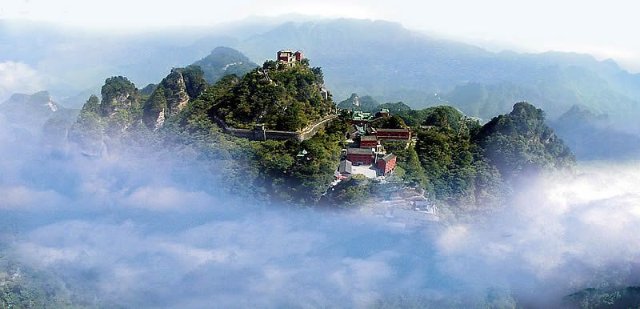China's Wudang Mountain
Plethora of Ancient Temples
By: Cheng Tong - Sep 25, 2024
Wudang Mountain, a UNESCO World Heritage Site located in Hubei Province, China, is renowned for its breathtaking landscapes, rich cultural heritage, and, most notably, its intricate system of Daoist temples. These temples, nestled amidst the towering peaks and verdant valleys, offer a glimpse into the profound philosophy and practices of Daoism.
Daoism, one of the major philosophical and religious traditions of China, emphasizes harmony with nature, simplicity, and the pursuit of immortality. Wudang Mountain, with its majestic natural beauty and spiritual energy, became an ideal location for Daoist practitioners to establish their monasteries and cultivate their spiritual paths.
The most iconic Daoist temple on Wudang Mountain is the Golden Summit Temple, situated atop the highest peak, Jade Emperor Peak. This temple is dedicated to the Jade Emperor, a supreme deity in Daoist mythology, and is a symbol of the mountain’s spiritual significance. The temple’s architecture is awe-inspiring, with intricate carvings, colorful murals, and a grand main hall housing a colossal statue of the Jade Emperor.
Another significant temple is the Nanyan Temple, located at the foot of the mountain. This temple is known for its stunning natural surroundings, including a cascading waterfall and a peaceful lake. Nanyan Temple is home to a variety of Daoist deities, including the Eight Immortals and the Three Pure Ones. Visitors can explore the temple’s tranquil gardens, meditate in the serene atmosphere, and learn about the history of Daoism.
The Purple Cloud Palace is another important Daoist complex on Wudang Mountain. In the picture above, I am standing in front of it. This palace is renowned for its beautiful architecture, including the towering Purple Cloud Tower. The palace is dedicated to the Three Pure Ones – The Jade Pure One, YiaoTianzun; The Supreme Pure One,Lingbao Tianzun; and, The Grand Pure One, Daode Tianzun – considered the highest deities in Daoism. Visitors can explore the palace’s various halls, each dedicated to a different aspect of Daoist belief, and admire the intricate carvings and paintings.
In addition to these major temples, Wudang Mountain is home to numerous smaller temples and monasteries, each with its own unique history and character. These temples often feature traditional Daoist practices, such as Tai Chi, meditation, and internal alchemy. Visitors can explore these temples to learn more about the diverse aspects of Daoist culture.
One of the most fascinating aspects of Wudang Mountain’s Daoist temples is their intricate architecture. The temples are often constructed using traditional Chinese building techniques, with curved roofs, ornate carvings, and harmonious proportions. The architecture is designed to create a sense of peace and tranquility, and to reflect the harmony between humans and nature that is central to Daoist philosophy.
I had the opportunity to spend time on Wudang Mountain and the city of Wudangshan at the entrance to the mountain range, and wrote about it in my book “Along The Way To Wudang.” To help you have a greater sense of the mountains and the temples that sit on them, I recommend this video documentary about Wudang.
There were 72 temples on Wudang, although some of them have fallen into disrepair and collapsed into ruins. Those that remain, though, are beautiful and inspiring, and I worshiped in many of them on my climb to the summit.
The view from the top of Wudang can not be described adequately; it can only be experienced. It was eight years ago that I stood atop it looking out, down, and all around, and I can still feel that experience in my waters.
Short of traveling to Wudang, you can watch the video for meaningful insight into Daoism and the allure, the magic, and the sacredness of Wudang. I commend it to you.

